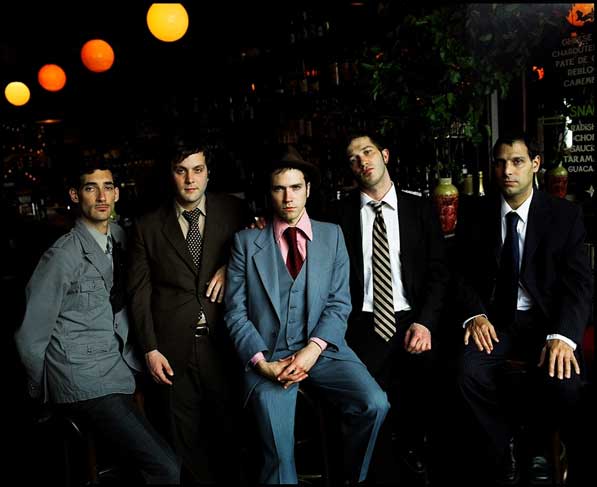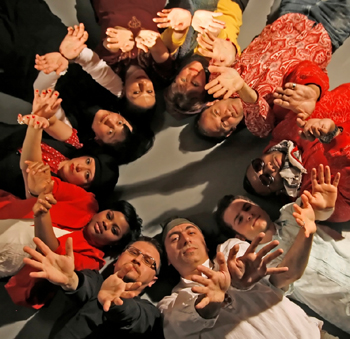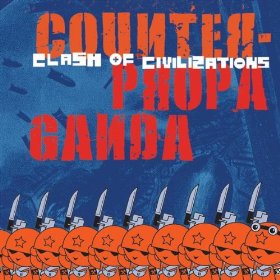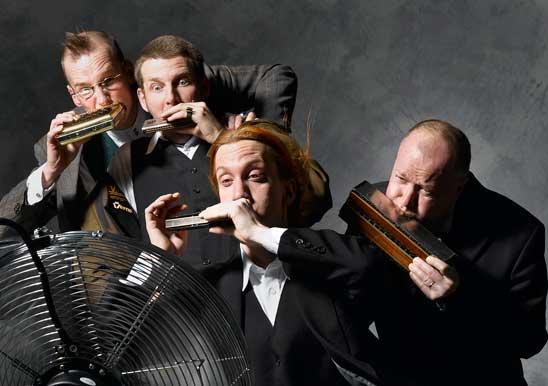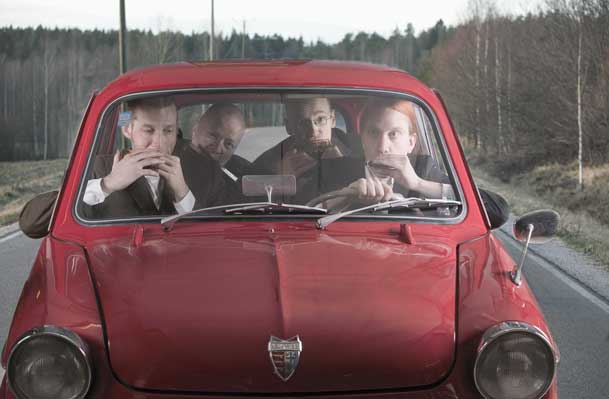Out of Africa: Hazanut And the Blues
The Sway Machinery Is En Route to Mali
‘In an Islamic country where Judaism was banned at various points in its history, we have been invited to bring our voice of New Jewish Music before an audience of thousands.’
By Jeremiah Lockwood
Musician and native-born New Yorker Jeremiah Lockwood is taking his band, The Sway Machinery, to Mali this month, with Emmy Award winning documentary filmmaker Jonathan Hock filming the event from beginning to end. Titled Pilgrimage, Hock’s film will follow Lockwood and the Sway Machinery on their extraordinary journey through the Sahara Desert and Malian recording sessions as ombudsmen of peace, reconciliation and collaborataive musical discovery. Grandson of renowned Cantor Jacob Konigsberg, Lockwood is humbled at being chosen to carry the cantorial tradition deep into the Sahara. “I admire the festival organizers’ courage in having me as their first Jewish featured artist. Inviting the Sway Machinery shows that they really have their ears to the ground for new innovations in traditional music,” Lockwood says. Lockwood was the subject of a profile in the June 2008 issue of TheBluegrassSpecial.com (http://thebluegrassspecial.com/archive/2008/june2008/gospelsetjune08.php)
I listen to music as an act of perceiving history. I am listening to hear the voices of ghosts from bygone days, who sang their songs before I was born. And when I sing the music of my own family's past, I feel that I am receiving a surer transmission from the recesses of history than any written history could promise.
The paths by which traditional music travels into the present from the past have been as serpentine and complex as the routes that the merchants of antiquity took across desert trade roads. With each iteration of a melody, changing details of a story or the strictures of a particular religious practice, the information would subtly yet distinctly change, reflecting the needs of both listener and place. In this way, strange and wonderful transformations of cultural ideas take place, engendering constant change and newness in the realms of folk culture.
Growing up, the first music that I came to love on my own, separate from my family's cantorial music tradition or the European classical music I heard from my father, was the blues—specifically, the classic 78-rpm recordings of prewar rural blues guitarist-poet-singers, artists like Charley Patton, Bukka White and Blind Lemon Jefferson. Their voices opened a passageway into an art of truth telling that was both a product of its culture and a forum for transcendent personal expression.
This is the nature of the bard—the communal storyteller—to be a complete servant of the cultural knowledge he possesses and to simultaneously struggle to create new art. The fact that both blues singers and hazanim share this communal role is part of what unconsciously drew me into this musical art form.
My passion for blues music drove me to study it like a science. And as should any respectful student of a tradition, I sought to know its history. This led me to the music of Mali, a West African nation linked by history to the Americas through the slave trade. When listening to artists like Boubacar Traore and Ali Farka Toure, contemporary masters of Malian music, you hear the incredible modal and rhythmic connections to American blues music. The musical traditions of the Islamic African lands asserted themselves as being particularly pugnacious in their survival in the New World.
The Sway Machinery (Jeremiah Lockwood, center)Listening to the blues, I hear the musical traditions of Mali, and listening to the classics of Malian music, I hear the profound impact of the music of Islam, as is befitting of a nation that has been Muslim since the 11th century. In the particular modalities of Malian music, the muezzin call and the cantillation of the Quran are indelibly present. In Malian music, I hear the integration of disparate cultural strains into one living strand where no one element is foreign or takes precedence over the other.
In my work with The Sway Machinery, a musical project exploring the cantorial music tradition, I look to Malian musical history as a powerful paradigm. Jewish music came to America in the late 19th and early 20th century and almost immediately opened an ongoing dialogue with the African-derived forms of music in the New World. My work is a continuation of this process.
And now The Sway Machinery has been invited to play in Mali, at the Festival in the Desert, a music and culture festival established by the Tuareg to celebrate their truce after a violent uprising against the Malian government. In an Islamic country where Judaism was banned at various points in its history, we have been invited to bring our voice of New Jewish Music before an audience of thousands. To me, this feels very much like an opportunity to bring a diasporic thread full circle. The Muslims who left the Middle East to bring their religion into the depths of the Sahara desert will soon be met by a small convoy of Jews who were exiled from the Holy Land thousands of years ago and are now returning to the Old World via the New. It is a circuitous route opened by the hands of passionate aesthetic imperatives. It is a meeting between cultures that I pray will be greeted with open arms on both sides.
(Reprinted by permission from The Jewish Daily Forward, http://forward.com/articles/121662/, December 23, 2009 issue.)
The Sway Machinery can use your help. Please make a donation to help the band defray its expenses for the Pilgrimage Project. Click on the link here and give generously. It’s tax deductible. The band is making its appeal through an affiliation with a registered 501(3)C tax-exempt trans-denominational non-profit arts and education organization called Joodayoh, the Sway Machinery Pilgrimage Project’s founding sponsor.https://npo.networkforgood.org/Donate/Donate.aspx?npoSubscriptionId=1001136&code=smalltsmpgeneric
***
Clash of CivilizationsThe Sound of Civilizations Clashing
‘A fascinating album full of searing hope and fierce optimism’
by Scott Allan Stevens
Photos by Roger Gordy
reprinted by permission from www.SoundRoots.org
A fascinating multicultural project, Clash of Civilizations not only puts musical traditions in a blender, but also sprinkles in those often taboo subjects, religion and politics. Boston-based composers Milan Kovacek (aka Hip Son, left in inset photo) and Nikola Radan (right) both hail from Serbia, a land that has suffered more than its share of clashes. They explain:
For centuries, a harmful myth has been perpetuated that we live in a divided world, that there are fundamental differences between races, cultures, and civilizations, and that this divide can only be bridged by military, economic, or cultural domination. The Clash of Civilizations collective represents one effort to challenge this myth by illustrating the common musical bonds found within all cultures.
Their album Counter Propaganda opens with "Declaration of Independence," blending beats with a recitation of portions of the historic American document and the powerful refrain of the traditional Black gospel song "Job:" "God giveth/God taketh/Blessed be the name of the Lord." Clash of Civilizations are willing to take on controversy and injustice wherever they see it. "Les Cities" is about the housing projects in Paris that house many Arabs and Muslims from former French colonies in North Africa. "Hiroshima" includes selections from President Truman's radio address following the bombing of the Japanese city along with traditional Japanese Imperial Palace music recorded during World War Two. And the title track lays the blame for cultural clashes squarely on the shoulders of our rulers:
Yet still, we are divided,
it's the clash of civilizations
controlled (of course) by governments' operations.Leaders of this world defuse your speech,
listen to the song of the crowd
singing Love out loud.
Clash of Civilizations, ‘Legacy’: ‘Clash of Civilizations not only puts musical traditions in a blender, but also sprinkles in those often taboo subjects, religion and politics.’Clash of Civilizations don't tar all leaders with this brush; they gained recognition in 2008 for recording a song called "Change in America" and subsequently donating it to the Obama campaign.
One of my early favorites is the song "Hagia Sophia," with lyrics that include the Trisagion ("Thrice Holy"), considered one of the oldest prayers in Christianity, and audio samples of an imam chanting from a mosque in Istanbul/Constantinople, a place Christians and Muslims worshiped and fought over. The song is embellished by elements of both Byzantine chanting and Middle Eastern instruments.
Though their loud, electronic-infused, often-brash music is pretty far removed from the rootsy songs we general prefer, Clash of Civilizations' social and political mission, and their clarity about where their songs come from make this a compelling album full of searing hope and fierce optimism.
Scott Allan Stevens is a photographer, writer, and radio DJ based in Olympia, Washington. His work appears at SoundRoots.org and he can be heard weekly on the KAOS-FM show, “Spin The Globe.” Read/see/hear more about his eclectic activities at www.earball.net
For more on Clash of Civilizations, visit the band’s website,
http://www.clashofcivilizationsmusic.com/index.html
Clash of Civilizations, Counter Propaganda
Buy it at www.amazon.com
***
Finland
Four men with harmonicas: (from left) Jouko Kyhälä, Eero Turkka, Eero (or Geero) Grundström, Pasi LeinoFour Men With Harmonicas Take Finnish Folk Music International
(With a tip of the hat to Jerry Murrad and His Harmonicats)
By Marko Latvanen
From http://finland.fi/Public/default.aspx?contentid=160046&nodeid=41798&culture=en-US
The case of Sväng, a harmonica quartet with a brand new take on the often overlooked instrument, is a perfect example of contemporary Finnish folk music striving for international renown in the world music arena. The group, rooted deeply in Finland's traditional music but also generously spiced with world music influences, was formed a few years ago almost coincidentally, during a student project at the Department of Folk Music at the Sibelius Academy in Helsinki. Since its inception, the department has been a veritable breeding ground for folk and traditional music talent in Finland.
From the very beginning, Sväng have focused on writing and performing their own material and pushing the boundaries of the harmonica. Not long after their formation they were a hot item in the domestic folk music field and got chosen as the Folk Music Ensemble of the Year at the Kaustinen Folk Music Festival, Finland's leading folk music fest. Since then, Sväng's concert schedule has been filling up with engagements mostly abroad, including the USA and Japan.
The secrets behind the unlikely ensemble's success are twofold. "First, the fact that they are unlikely and nothing like you would expect, is in itself a strong factor. They do innovative stuff you've never heard before, and that makes them interesting outright if you're a music fan," says Pekka Lehti, head of Aito Records, a folk and world music specialist label in Helsinki. "Second, they are just plain brilliant as musicians, they communicate wonderfully live. That's top priority because when you have a previously unknown group to market, you have to win live audiences over first. Record sales grow from that."
Sväng live at the Ateneum Club, Helsinki, Finland, November 2005, performing ‘Jampparaleele’ and ‘Sväng Time Rag’Jouko Kyhälä, Sväng's driving force and Finland's only harmonica professional with a doctorate in music from the Sibelius Academy, explains his group's agenda: "We go against the traditions of the genre. Harmonica quartets used to be mostly novelty acts, playing light classical music with an unlikely instrument. We, on the other hand, compose our own material and make just the kind of music we like. The influences from different cultures and periods in our music become integrated into the whole because we have our own sound and approach," Kyhälä says.
Both audiences and critics have noted and responded to Sväng's unique character and infectious enthusiasm. Kyhälä emphasizes the group's natural and spontaneous mode of working. "Sväng is what you might call 'a natural concept.’ No one designed or branded us. We simply got together, got excited about what we could do and decided to go on from there."
Music Fans, Networks and A Lot of Hard Work
But mere brilliance is not enough to carry a fairly new act into world music celebrity, even if the market is smaller and perhaps more intimate than that of the pop/rock production machinery. Old contacts have to be actively maintained, new ones created, and you have to stay in touch with the changing times.
Both Lehti and Kyhälä describe Sväng's core audience simply as "music fans," a heterogeneous group of people connected by active interest in music and other cultures. There are no specific target audiences, although Kyhälä jokingly adds, "If we were after big money, we should concentrate on financially well-off middle-aged women. They are the most active consumers of culture—and have the money to buy our CD after the concert."
The lack of target segmentation, combined with the fact that world and traditional music companies are usually small, leads to heavy reliance on personal contacts, B2B networking and live performances. Individual, committed agents or agencies abroad are absolutely essential in introducing a foreign artist into new markets.
But small size can also have definite benefits. "New communication technologies and the social web present a tough challenge to the big media corporations," Lehti points out. "The trend cycle is more hectic and less manageable than ever before, and it's hard for the big ones to keep up. Small companies that are used to cooperating and using the web as a sales and information channel can react faster."
Editor’s Note: Bass harmonica player Pasi Leino informs TheBluegrassSpecial.com that Sväng has completed its third album, with a scheduled May release in Japan “and a bit later elsewhere.”
Sväng performs ‘Kua Kua Kome Kiki’ with Jools Holland and the Rhythm and Blues Band, New Year’s, 2009From Svang's MySpace page (http://www.myspace.com/svangharmonica):
Dr. Jouko Kyhälä, who was teaching harmonica at the Sibelius Academy, teamed up with two of his students, Eero Turkka and Eero Grundström, to re-vitalize this bizarre, yet strangely appealing, form of ensemble. The concept was fulfilled when they were joined by veteran bass harp player Pasi Leino. The grounding element in this unique mixture of styles is the groove created by the rare chord harmonica Harmonetta and the incredibly low bass harmonica. The swinging groove and virtuoso soloists may appear somewhat nostalgic but inspired improvisations and a frantic stage manner bring this musical style bang up to date.
Svang, going mobile: (front, from left) Eero Turkka, Eero (or Geero) Grundström; (back, from left) Pasi Leino, Jouko KyhäläSväng, Man for Man
Eero Turkka, chromatic and diatonic harmonicas
Eero Turkka got interested in blues harp as a little boy and ended up studying in Sibelius Academy. Besides harmonica he plays several other ethnic instruments and sings in multiple bands, including Turkka & Paalanen, Äijä, Trepaanit and Cedip Tur. Eero has graduated from Sibelius Academy in 2006.Eero Grundström, chromatic and diatonic harmonicas
Eero Grundström is finalizing his studies in Sibelius Academy. He is also a multi-instrumentalist, composer and true improvisation wizard and has worked in all musical fields including free improvisation, theatre, circus, rock, jazz and modern. Apart from harmonica, Eero plays harmonium and other keyboards. His other projects are Spontaani Vire, Iso Karhu and Von & Af. Geero graduated from Sibelius Academy in 2008.Pasi Leino, bass harmonica
Pasi Leino is the most senior member of the band. He worked several years with a best known Finnish harmonica trio/quartet "Raimo Sirkiä.” This trio was active almost 10 years between 1980 and 1990.Jouko Kyhälä, chord harmonica "Harmonetta,” chromatic and diatonic harmonicas
Dr. Kyhälä graduated from Sibelius Academy folk music department in 1999 as the first to major in harmonica. He completed his post graduate studies and became the first Doctor of Harmonica Arts in April 2007. Kyhälä has multiple musical capacities having worked with folk, jazz, pop, improvisation and modern dance projects as a composer, musician, performer, etc. Kyhälä plays keyboards and harmonica in over 20 albums. His other projects include Markku Lepistö & co, Pekka Lehti & Outo Voima.Record Label
Aitorecords Ltd., independent
Founder/Publisher/Editor: David McGee
Contributing Editors: Billy Altman, Laura Fissinger, Christopher Hill, Derk Richardson
Logo Design: John Mendelsohn (www.johnmendelsohn.com)
Website Design: Kieran McGee (www.kieranmcgee.com)
Staff Photographers: Audrey Harrod (Louisville, KY; www.flickr.com/audreyharrod), Alicia Zappier (New York)
E-mail: thebluegrassspecial@gmail.com
Mailing Address: David McGee, 201 W. 85 St.—5B, New York, NY 10024


